MGT402 Case Study: HR Practices & Supply Chain Performance - Oman
VerifiedAdded on 2023/04/21
|75
|16356
|149
Case Study
AI Summary
This case study investigates the impact of Human Resources (HR) practices on the supply chain performance of Majan Electricity Company in Oman. The study, conducted as part of the MGT402 Graduation Project, covers various aspects including a literature review, research methodology, data analysis, and recommendations. The research identifies the problem statement, objectives, and significance of understanding how HR activities influence the efficiency and effectiveness of the supply chain network and distribution of services. The literature review explores historical backgrounds, relevant theories, and gaps in existing research. The methodology involves research questions, hypotheses, research design, sampling procedures, and data analysis techniques. The data analysis and interpretation chapter presents the findings of the study, followed by conclusions and recommendations aimed at improving HR practices to enhance supply chain performance. The study also acknowledges its limitations and suggests areas for future research. Desklib provides access to this solved assignment and many other resources for students.
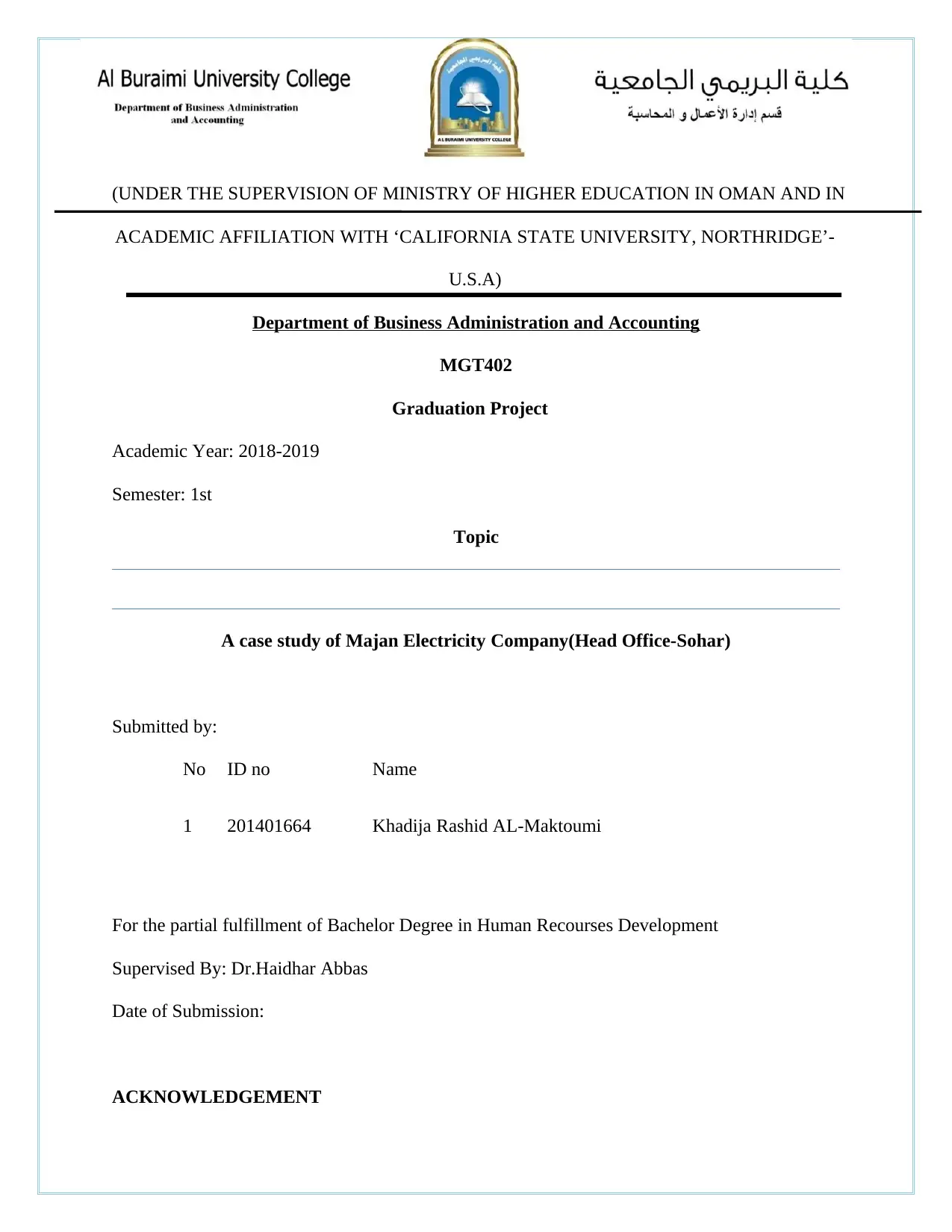
Running Head- The impact of HR practices on Supply Chain Performance of the organization
(UNDER THE SUPERVISION OF MINISTRY OF HIGHER EDUCATION IN OMAN AND IN
ACADEMIC AFFILIATION WITH ‘CALIFORNIA STATE UNIVERSITY, NORTHRIDGE’-
U.S.A)
Department of Business Administration and Accounting
MGT402
Graduation Project
Academic Year: 2018-2019
Semester: 1st
Topic
A case study of Majan Electricity Company(Head Office-Sohar)
Submitted by:
No ID no Name
1 201401664 Khadija Rashid AL-Maktoumi
For the partial fulfillment of Bachelor Degree in Human Recourses Development
Supervised By: Dr.Haidhar Abbas
Date of Submission:
ACKNOWLEDGEMENT
(UNDER THE SUPERVISION OF MINISTRY OF HIGHER EDUCATION IN OMAN AND IN
ACADEMIC AFFILIATION WITH ‘CALIFORNIA STATE UNIVERSITY, NORTHRIDGE’-
U.S.A)
Department of Business Administration and Accounting
MGT402
Graduation Project
Academic Year: 2018-2019
Semester: 1st
Topic
A case study of Majan Electricity Company(Head Office-Sohar)
Submitted by:
No ID no Name
1 201401664 Khadija Rashid AL-Maktoumi
For the partial fulfillment of Bachelor Degree in Human Recourses Development
Supervised By: Dr.Haidhar Abbas
Date of Submission:
ACKNOWLEDGEMENT
Paraphrase This Document
Need a fresh take? Get an instant paraphrase of this document with our AI Paraphraser

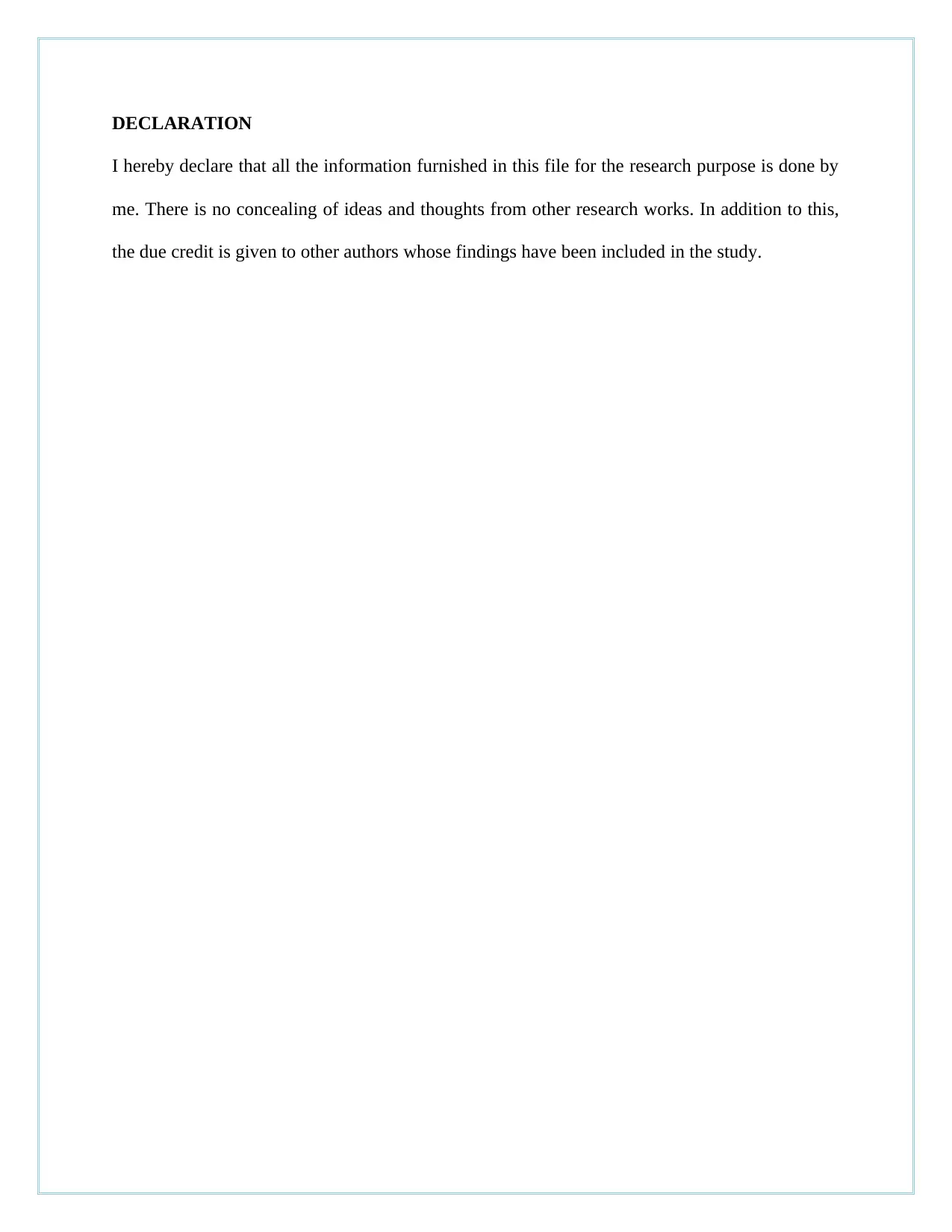
DECLARATION
I hereby declare that all the information furnished in this file for the research purpose is done by
me. There is no concealing of ideas and thoughts from other research works. In addition to this,
the due credit is given to other authors whose findings have been included in the study.
I hereby declare that all the information furnished in this file for the research purpose is done by
me. There is no concealing of ideas and thoughts from other research works. In addition to this,
the due credit is given to other authors whose findings have been included in the study.
⊘ This is a preview!⊘
Do you want full access?
Subscribe today to unlock all pages.

Trusted by 1+ million students worldwide
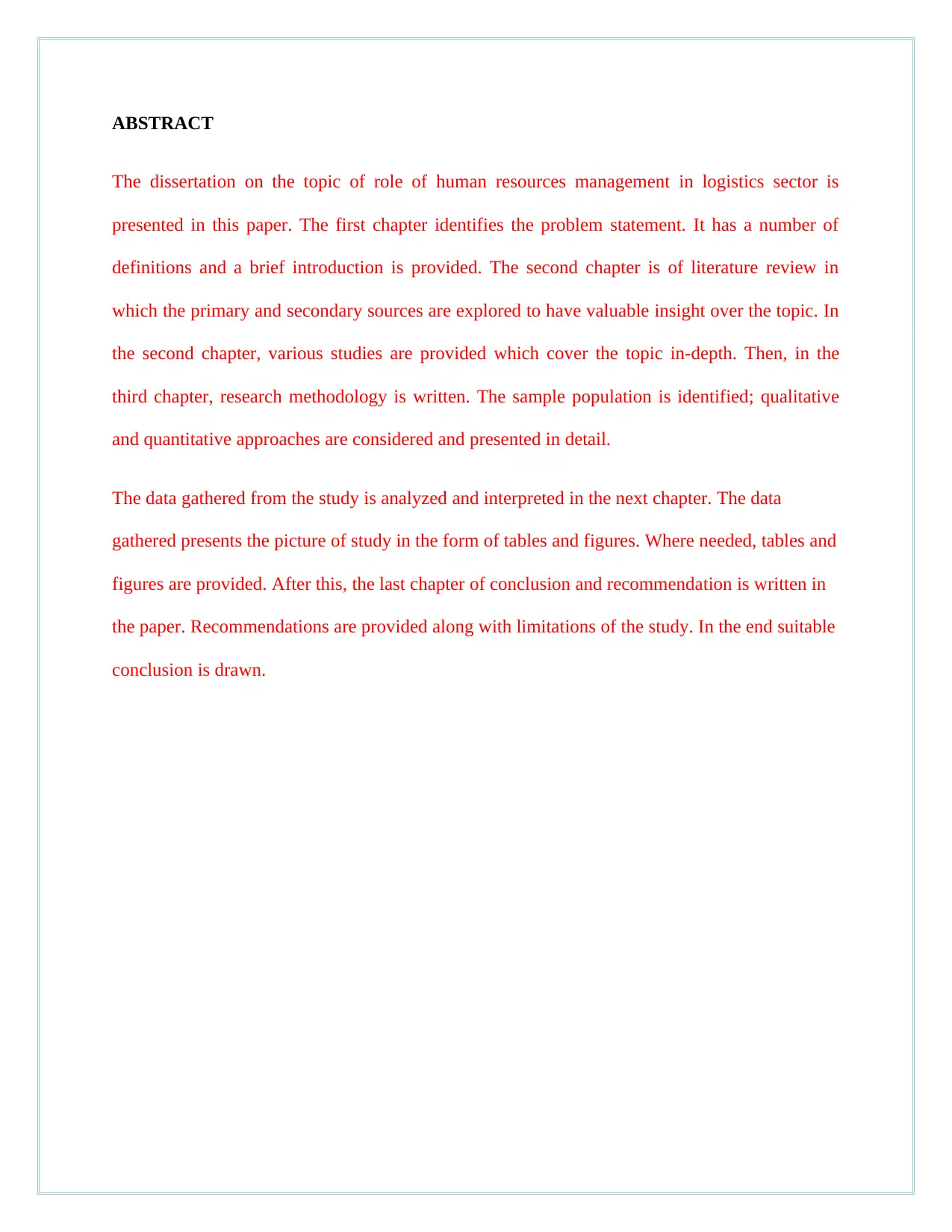
ABSTRACT
The dissertation on the topic of role of human resources management in logistics sector is
presented in this paper. The first chapter identifies the problem statement. It has a number of
definitions and a brief introduction is provided. The second chapter is of literature review in
which the primary and secondary sources are explored to have valuable insight over the topic. In
the second chapter, various studies are provided which cover the topic in-depth. Then, in the
third chapter, research methodology is written. The sample population is identified; qualitative
and quantitative approaches are considered and presented in detail.
The data gathered from the study is analyzed and interpreted in the next chapter. The data
gathered presents the picture of study in the form of tables and figures. Where needed, tables and
figures are provided. After this, the last chapter of conclusion and recommendation is written in
the paper. Recommendations are provided along with limitations of the study. In the end suitable
conclusion is drawn.
The dissertation on the topic of role of human resources management in logistics sector is
presented in this paper. The first chapter identifies the problem statement. It has a number of
definitions and a brief introduction is provided. The second chapter is of literature review in
which the primary and secondary sources are explored to have valuable insight over the topic. In
the second chapter, various studies are provided which cover the topic in-depth. Then, in the
third chapter, research methodology is written. The sample population is identified; qualitative
and quantitative approaches are considered and presented in detail.
The data gathered from the study is analyzed and interpreted in the next chapter. The data
gathered presents the picture of study in the form of tables and figures. Where needed, tables and
figures are provided. After this, the last chapter of conclusion and recommendation is written in
the paper. Recommendations are provided along with limitations of the study. In the end suitable
conclusion is drawn.
Paraphrase This Document
Need a fresh take? Get an instant paraphrase of this document with our AI Paraphraser
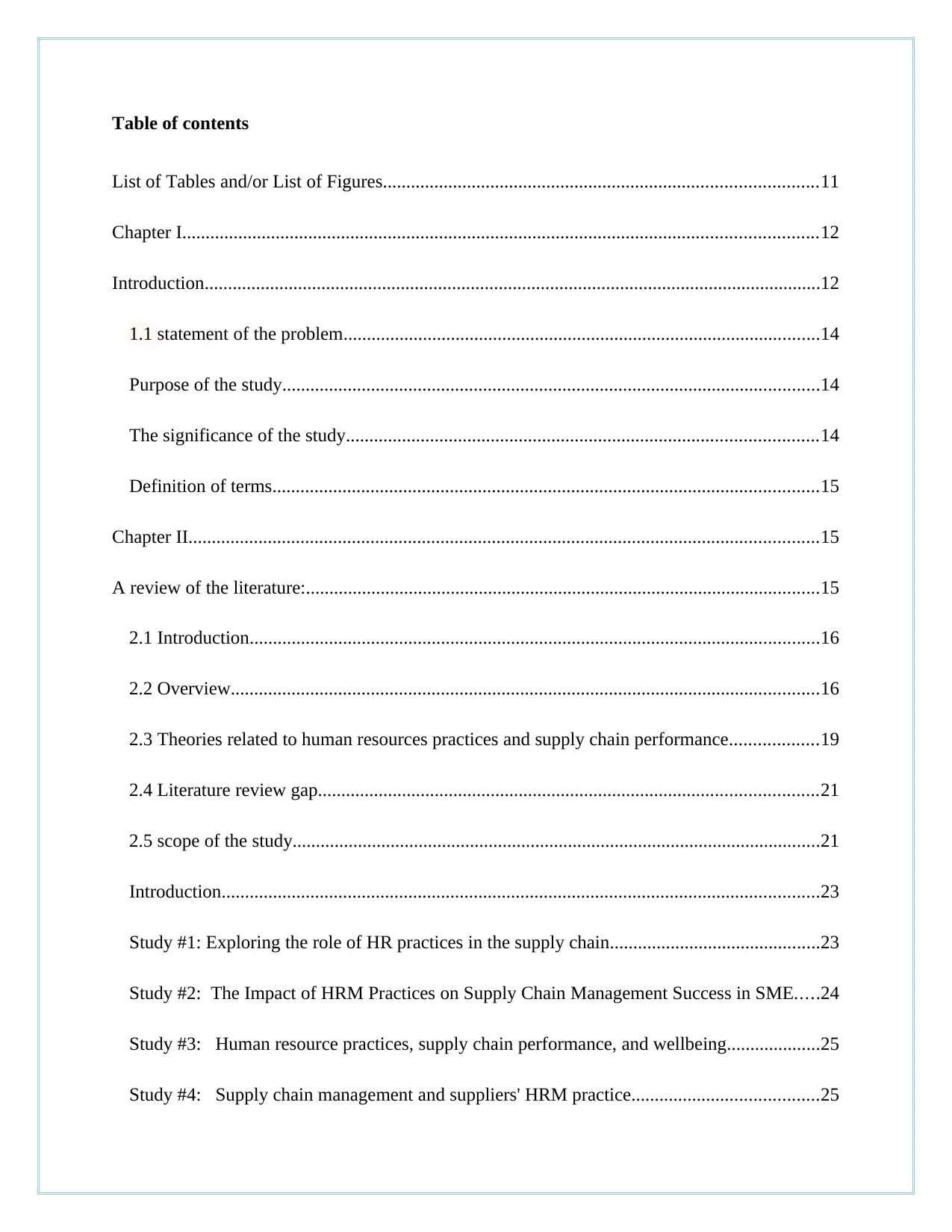
Table of contents
List of Tables and/or List of Figures.............................................................................................11
Chapter I........................................................................................................................................12
Introduction....................................................................................................................................12
1.1 statement of the problem......................................................................................................14
Purpose of the study...................................................................................................................14
The significance of the study.....................................................................................................14
Definition of terms.....................................................................................................................15
Chapter II.......................................................................................................................................15
A review of the literature:..............................................................................................................15
2.1 Introduction..........................................................................................................................16
2.2 Overview..............................................................................................................................16
2.3 Theories related to human resources practices and supply chain performance...................19
2.4 Literature review gap...........................................................................................................21
2.5 scope of the study.................................................................................................................21
Introduction................................................................................................................................23
Study #1: Exploring the role of HR practices in the supply chain.............................................23
Study #2: The Impact of HRM Practices on Supply Chain Management Success in SME.....24
Study #3: Human resource practices, supply chain performance, and wellbeing....................25
Study #4: Supply chain management and suppliers' HRM practice........................................25
List of Tables and/or List of Figures.............................................................................................11
Chapter I........................................................................................................................................12
Introduction....................................................................................................................................12
1.1 statement of the problem......................................................................................................14
Purpose of the study...................................................................................................................14
The significance of the study.....................................................................................................14
Definition of terms.....................................................................................................................15
Chapter II.......................................................................................................................................15
A review of the literature:..............................................................................................................15
2.1 Introduction..........................................................................................................................16
2.2 Overview..............................................................................................................................16
2.3 Theories related to human resources practices and supply chain performance...................19
2.4 Literature review gap...........................................................................................................21
2.5 scope of the study.................................................................................................................21
Introduction................................................................................................................................23
Study #1: Exploring the role of HR practices in the supply chain.............................................23
Study #2: The Impact of HRM Practices on Supply Chain Management Success in SME.....24
Study #3: Human resource practices, supply chain performance, and wellbeing....................25
Study #4: Supply chain management and suppliers' HRM practice........................................25
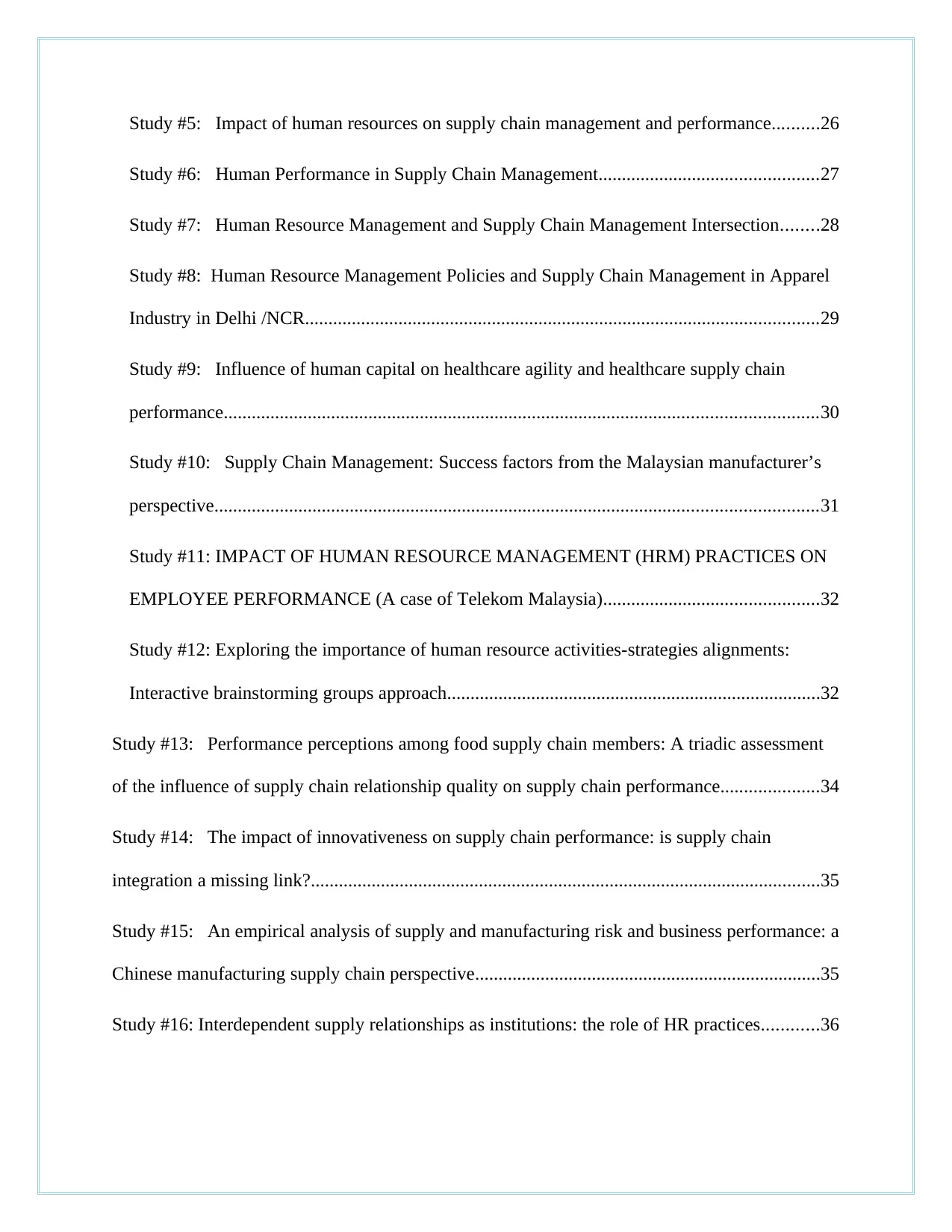
Study #5: Impact of human resources on supply chain management and performance..........26
Study #6: Human Performance in Supply Chain Management...............................................27
Study #7: Human Resource Management and Supply Chain Management Intersection........28
Study #8: Human Resource Management Policies and Supply Chain Management in Apparel
Industry in Delhi /NCR..............................................................................................................29
Study #9: Influence of human capital on healthcare agility and healthcare supply chain
performance...............................................................................................................................30
Study #10: Supply Chain Management: Success factors from the Malaysian manufacturer’s
perspective.................................................................................................................................31
Study #11: IMPACT OF HUMAN RESOURCE MANAGEMENT (HRM) PRACTICES ON
EMPLOYEE PERFORMANCE (A case of Telekom Malaysia)..............................................32
Study #12: Exploring the importance of human resource activities-strategies alignments:
Interactive brainstorming groups approach................................................................................32
Study #13: Performance perceptions among food supply chain members: A triadic assessment
of the influence of supply chain relationship quality on supply chain performance.....................34
Study #14: The impact of innovativeness on supply chain performance: is supply chain
integration a missing link?.............................................................................................................35
Study #15: An empirical analysis of supply and manufacturing risk and business performance: a
Chinese manufacturing supply chain perspective..........................................................................35
Study #16: Interdependent supply relationships as institutions: the role of HR practices............36
Study #6: Human Performance in Supply Chain Management...............................................27
Study #7: Human Resource Management and Supply Chain Management Intersection........28
Study #8: Human Resource Management Policies and Supply Chain Management in Apparel
Industry in Delhi /NCR..............................................................................................................29
Study #9: Influence of human capital on healthcare agility and healthcare supply chain
performance...............................................................................................................................30
Study #10: Supply Chain Management: Success factors from the Malaysian manufacturer’s
perspective.................................................................................................................................31
Study #11: IMPACT OF HUMAN RESOURCE MANAGEMENT (HRM) PRACTICES ON
EMPLOYEE PERFORMANCE (A case of Telekom Malaysia)..............................................32
Study #12: Exploring the importance of human resource activities-strategies alignments:
Interactive brainstorming groups approach................................................................................32
Study #13: Performance perceptions among food supply chain members: A triadic assessment
of the influence of supply chain relationship quality on supply chain performance.....................34
Study #14: The impact of innovativeness on supply chain performance: is supply chain
integration a missing link?.............................................................................................................35
Study #15: An empirical analysis of supply and manufacturing risk and business performance: a
Chinese manufacturing supply chain perspective..........................................................................35
Study #16: Interdependent supply relationships as institutions: the role of HR practices............36
⊘ This is a preview!⊘
Do you want full access?
Subscribe today to unlock all pages.

Trusted by 1+ million students worldwide
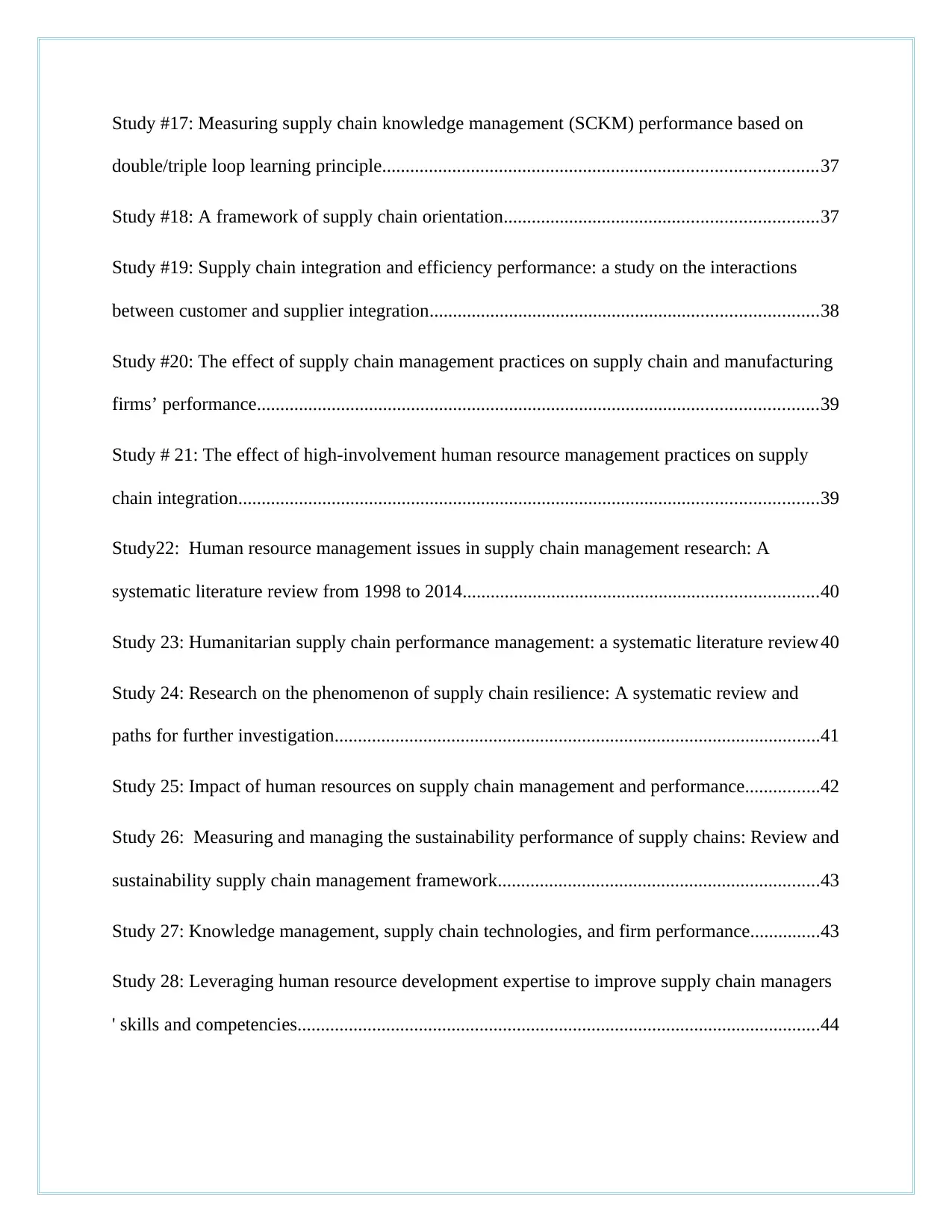
Study #17: Measuring supply chain knowledge management (SCKM) performance based on
double/triple loop learning principle.............................................................................................37
Study #18: A framework of supply chain orientation...................................................................37
Study #19: Supply chain integration and efficiency performance: a study on the interactions
between customer and supplier integration...................................................................................38
Study #20: The effect of supply chain management practices on supply chain and manufacturing
firms’ performance........................................................................................................................39
Study # 21: The effect of high-involvement human resource management practices on supply
chain integration............................................................................................................................39
Study22: Human resource management issues in supply chain management research: A
systematic literature review from 1998 to 2014............................................................................40
Study 23: Humanitarian supply chain performance management: a systematic literature review 40
Study 24: Research on the phenomenon of supply chain resilience: A systematic review and
paths for further investigation........................................................................................................41
Study 25: Impact of human resources on supply chain management and performance................42
Study 26: Measuring and managing the sustainability performance of supply chains: Review and
sustainability supply chain management framework.....................................................................43
Study 27: Knowledge management, supply chain technologies, and firm performance...............43
Study 28: Leveraging human resource development expertise to improve supply chain managers
' skills and competencies................................................................................................................44
double/triple loop learning principle.............................................................................................37
Study #18: A framework of supply chain orientation...................................................................37
Study #19: Supply chain integration and efficiency performance: a study on the interactions
between customer and supplier integration...................................................................................38
Study #20: The effect of supply chain management practices on supply chain and manufacturing
firms’ performance........................................................................................................................39
Study # 21: The effect of high-involvement human resource management practices on supply
chain integration............................................................................................................................39
Study22: Human resource management issues in supply chain management research: A
systematic literature review from 1998 to 2014............................................................................40
Study 23: Humanitarian supply chain performance management: a systematic literature review 40
Study 24: Research on the phenomenon of supply chain resilience: A systematic review and
paths for further investigation........................................................................................................41
Study 25: Impact of human resources on supply chain management and performance................42
Study 26: Measuring and managing the sustainability performance of supply chains: Review and
sustainability supply chain management framework.....................................................................43
Study 27: Knowledge management, supply chain technologies, and firm performance...............43
Study 28: Leveraging human resource development expertise to improve supply chain managers
' skills and competencies................................................................................................................44
Paraphrase This Document
Need a fresh take? Get an instant paraphrase of this document with our AI Paraphraser

Study 29: Identifying the drivers of enterprise resource planning and assessing its impacts on
supply chain performances............................................................................................................45
Study 30: Business excellence through total supply chain quality management..........................46
Chapter3 Research Methodology..................................................................................................48
3.1 Introduction..........................................................................................................................48
3.2 Research Questions..............................................................................................................48
3.3 Objectives and Hypotheses..................................................................................................49
3.4 Research Design...................................................................................................................49
3.5 Sampling Procedure.............................................................................................................50
3.6 Tools and Techniques used for Data Analysis.....................................................................50
Chapter 4 Data Analysis and Interpretation...................................................................................53
4.1 Introduction..........................................................................................................................53
4.2 Data Analysis and Interpretation..........................................................................................54
4.3. Summary of Results............................................................................................................56
Chapter 5 Findings, Conclusions and Recommendations.............................................................70
5.1 Major Findings of the study.................................................................................................70
5.2 Conclusion...........................................................................................................................70
5.3 Key Recommendations........................................................................................................71
5.4 Implications of the study......................................................................................................71
5.5 Limitation of the study and scope for future research.........................................................71
supply chain performances............................................................................................................45
Study 30: Business excellence through total supply chain quality management..........................46
Chapter3 Research Methodology..................................................................................................48
3.1 Introduction..........................................................................................................................48
3.2 Research Questions..............................................................................................................48
3.3 Objectives and Hypotheses..................................................................................................49
3.4 Research Design...................................................................................................................49
3.5 Sampling Procedure.............................................................................................................50
3.6 Tools and Techniques used for Data Analysis.....................................................................50
Chapter 4 Data Analysis and Interpretation...................................................................................53
4.1 Introduction..........................................................................................................................53
4.2 Data Analysis and Interpretation..........................................................................................54
4.3. Summary of Results............................................................................................................56
Chapter 5 Findings, Conclusions and Recommendations.............................................................70
5.1 Major Findings of the study.................................................................................................70
5.2 Conclusion...........................................................................................................................70
5.3 Key Recommendations........................................................................................................71
5.4 Implications of the study......................................................................................................71
5.5 Limitation of the study and scope for future research.........................................................71

References......................................................................................................................................72
⊘ This is a preview!⊘
Do you want full access?
Subscribe today to unlock all pages.

Trusted by 1+ million students worldwide
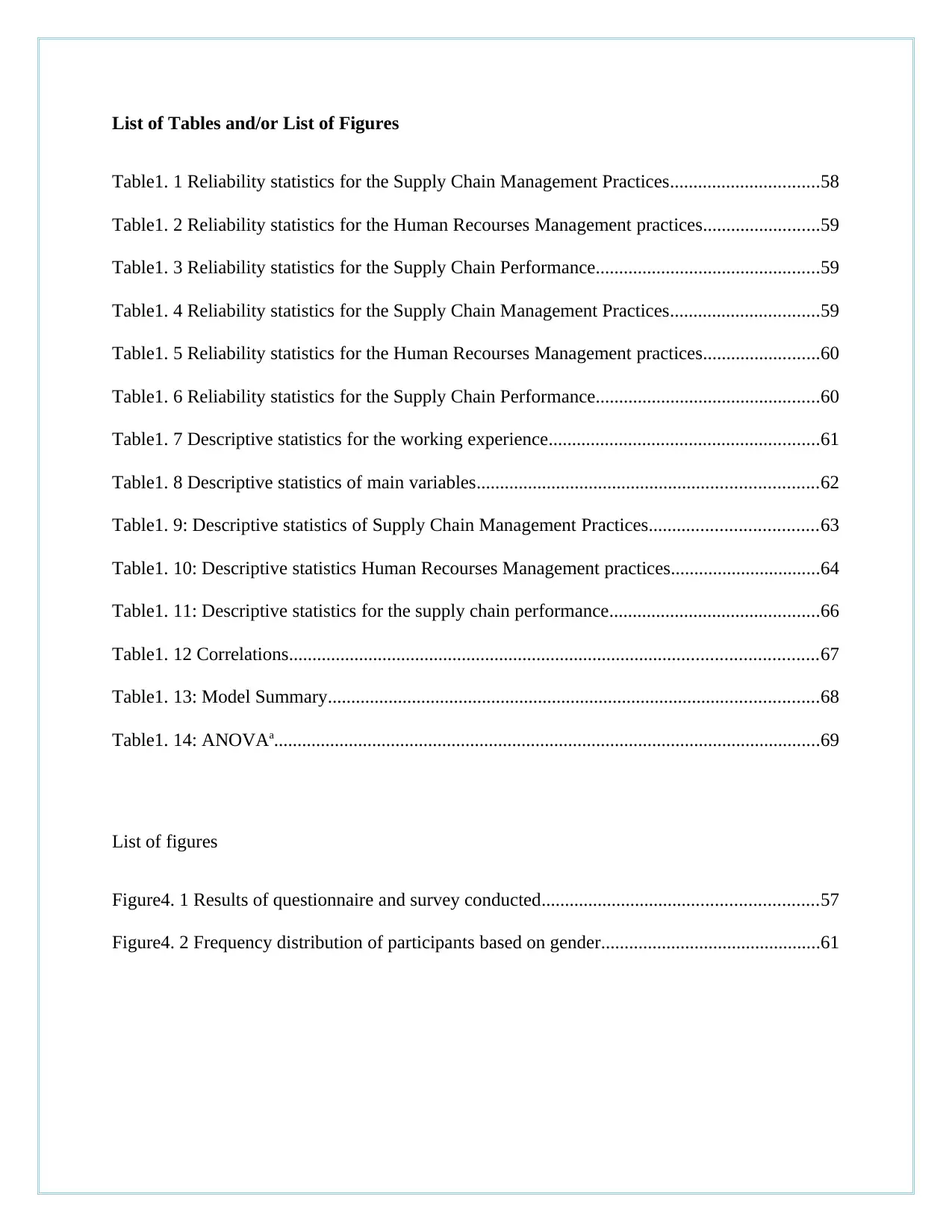
List of Tables and/or List of Figures
Table1. 1 Reliability statistics for the Supply Chain Management Practices................................58
Table1. 2 Reliability statistics for the Human Recourses Management practices.........................59
Table1. 3 Reliability statistics for the Supply Chain Performance................................................59
Table1. 4 Reliability statistics for the Supply Chain Management Practices................................59
Table1. 5 Reliability statistics for the Human Recourses Management practices.........................60
Table1. 6 Reliability statistics for the Supply Chain Performance................................................60
Table1. 7 Descriptive statistics for the working experience..........................................................61
Table1. 8 Descriptive statistics of main variables.........................................................................62
Table1. 9: Descriptive statistics of Supply Chain Management Practices....................................63
Table1. 10: Descriptive statistics Human Recourses Management practices................................64
Table1. 11: Descriptive statistics for the supply chain performance.............................................66
Table1. 12 Correlations.................................................................................................................67
Table1. 13: Model Summary.........................................................................................................68
Table1. 14: ANOVAa.....................................................................................................................69
List of figures
Figure4. 1 Results of questionnaire and survey conducted...........................................................57
Figure4. 2 Frequency distribution of participants based on gender...............................................61
Table1. 1 Reliability statistics for the Supply Chain Management Practices................................58
Table1. 2 Reliability statistics for the Human Recourses Management practices.........................59
Table1. 3 Reliability statistics for the Supply Chain Performance................................................59
Table1. 4 Reliability statistics for the Supply Chain Management Practices................................59
Table1. 5 Reliability statistics for the Human Recourses Management practices.........................60
Table1. 6 Reliability statistics for the Supply Chain Performance................................................60
Table1. 7 Descriptive statistics for the working experience..........................................................61
Table1. 8 Descriptive statistics of main variables.........................................................................62
Table1. 9: Descriptive statistics of Supply Chain Management Practices....................................63
Table1. 10: Descriptive statistics Human Recourses Management practices................................64
Table1. 11: Descriptive statistics for the supply chain performance.............................................66
Table1. 12 Correlations.................................................................................................................67
Table1. 13: Model Summary.........................................................................................................68
Table1. 14: ANOVAa.....................................................................................................................69
List of figures
Figure4. 1 Results of questionnaire and survey conducted...........................................................57
Figure4. 2 Frequency distribution of participants based on gender...............................................61
Paraphrase This Document
Need a fresh take? Get an instant paraphrase of this document with our AI Paraphraser
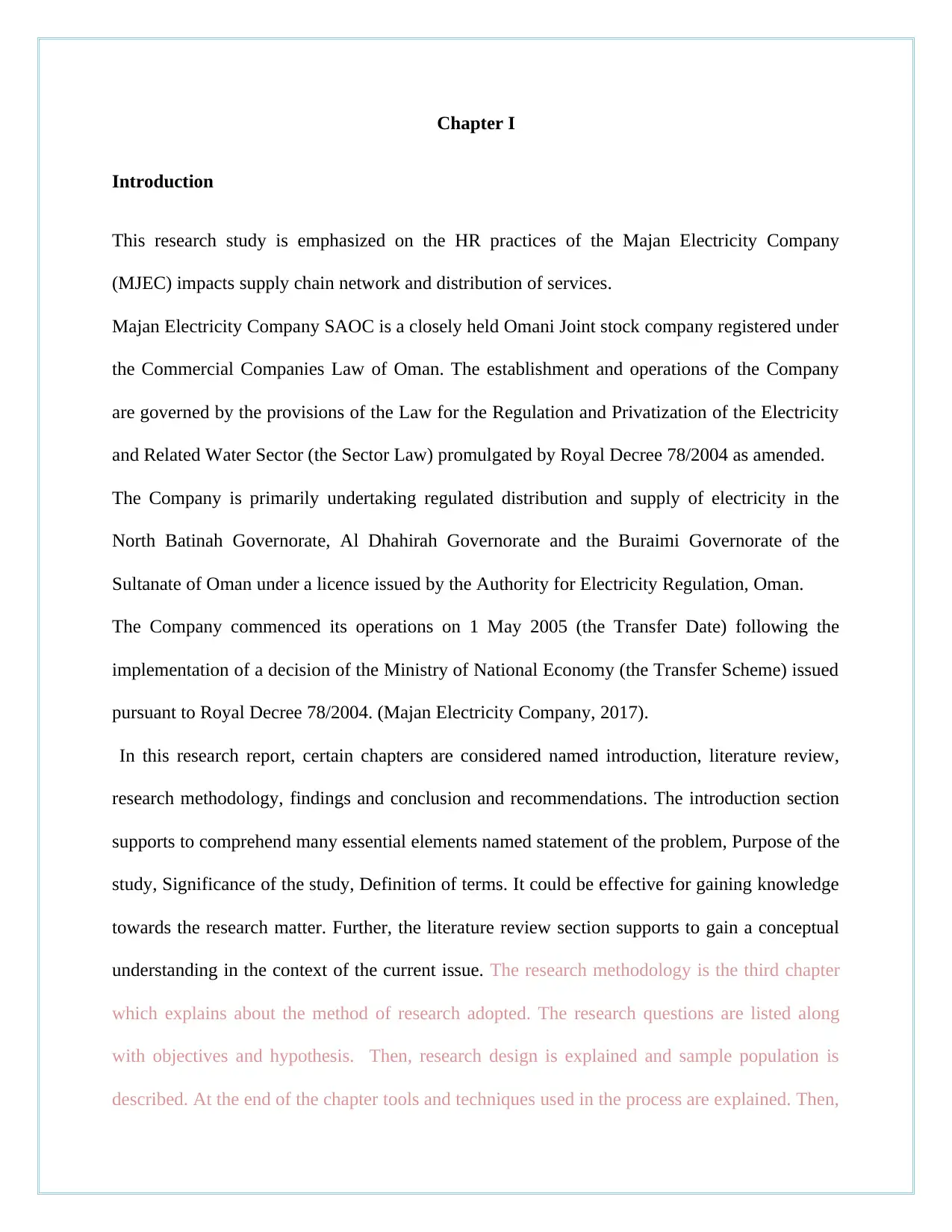
Chapter I
Introduction
This research study is emphasized on the HR practices of the Majan Electricity Company
(MJEC) impacts supply chain network and distribution of services.
Majan Electricity Company SAOC is a closely held Omani Joint stock company registered under
the Commercial Companies Law of Oman. The establishment and operations of the Company
are governed by the provisions of the Law for the Regulation and Privatization of the Electricity
and Related Water Sector (the Sector Law) promulgated by Royal Decree 78/2004 as amended.
The Company is primarily undertaking regulated distribution and supply of electricity in the
North Batinah Governorate, Al Dhahirah Governorate and the Buraimi Governorate of the
Sultanate of Oman under a licence issued by the Authority for Electricity Regulation, Oman.
The Company commenced its operations on 1 May 2005 (the Transfer Date) following the
implementation of a decision of the Ministry of National Economy (the Transfer Scheme) issued
pursuant to Royal Decree 78/2004. (Majan Electricity Company, 2017).
In this research report, certain chapters are considered named introduction, literature review,
research methodology, findings and conclusion and recommendations. The introduction section
supports to comprehend many essential elements named statement of the problem, Purpose of the
study, Significance of the study, Definition of terms. It could be effective for gaining knowledge
towards the research matter. Further, the literature review section supports to gain a conceptual
understanding in the context of the current issue. The research methodology is the third chapter
which explains about the method of research adopted. The research questions are listed along
with objectives and hypothesis. Then, research design is explained and sample population is
described. At the end of the chapter tools and techniques used in the process are explained. Then,
Introduction
This research study is emphasized on the HR practices of the Majan Electricity Company
(MJEC) impacts supply chain network and distribution of services.
Majan Electricity Company SAOC is a closely held Omani Joint stock company registered under
the Commercial Companies Law of Oman. The establishment and operations of the Company
are governed by the provisions of the Law for the Regulation and Privatization of the Electricity
and Related Water Sector (the Sector Law) promulgated by Royal Decree 78/2004 as amended.
The Company is primarily undertaking regulated distribution and supply of electricity in the
North Batinah Governorate, Al Dhahirah Governorate and the Buraimi Governorate of the
Sultanate of Oman under a licence issued by the Authority for Electricity Regulation, Oman.
The Company commenced its operations on 1 May 2005 (the Transfer Date) following the
implementation of a decision of the Ministry of National Economy (the Transfer Scheme) issued
pursuant to Royal Decree 78/2004. (Majan Electricity Company, 2017).
In this research report, certain chapters are considered named introduction, literature review,
research methodology, findings and conclusion and recommendations. The introduction section
supports to comprehend many essential elements named statement of the problem, Purpose of the
study, Significance of the study, Definition of terms. It could be effective for gaining knowledge
towards the research matter. Further, the literature review section supports to gain a conceptual
understanding in the context of the current issue. The research methodology is the third chapter
which explains about the method of research adopted. The research questions are listed along
with objectives and hypothesis. Then, research design is explained and sample population is
described. At the end of the chapter tools and techniques used in the process are explained. Then,
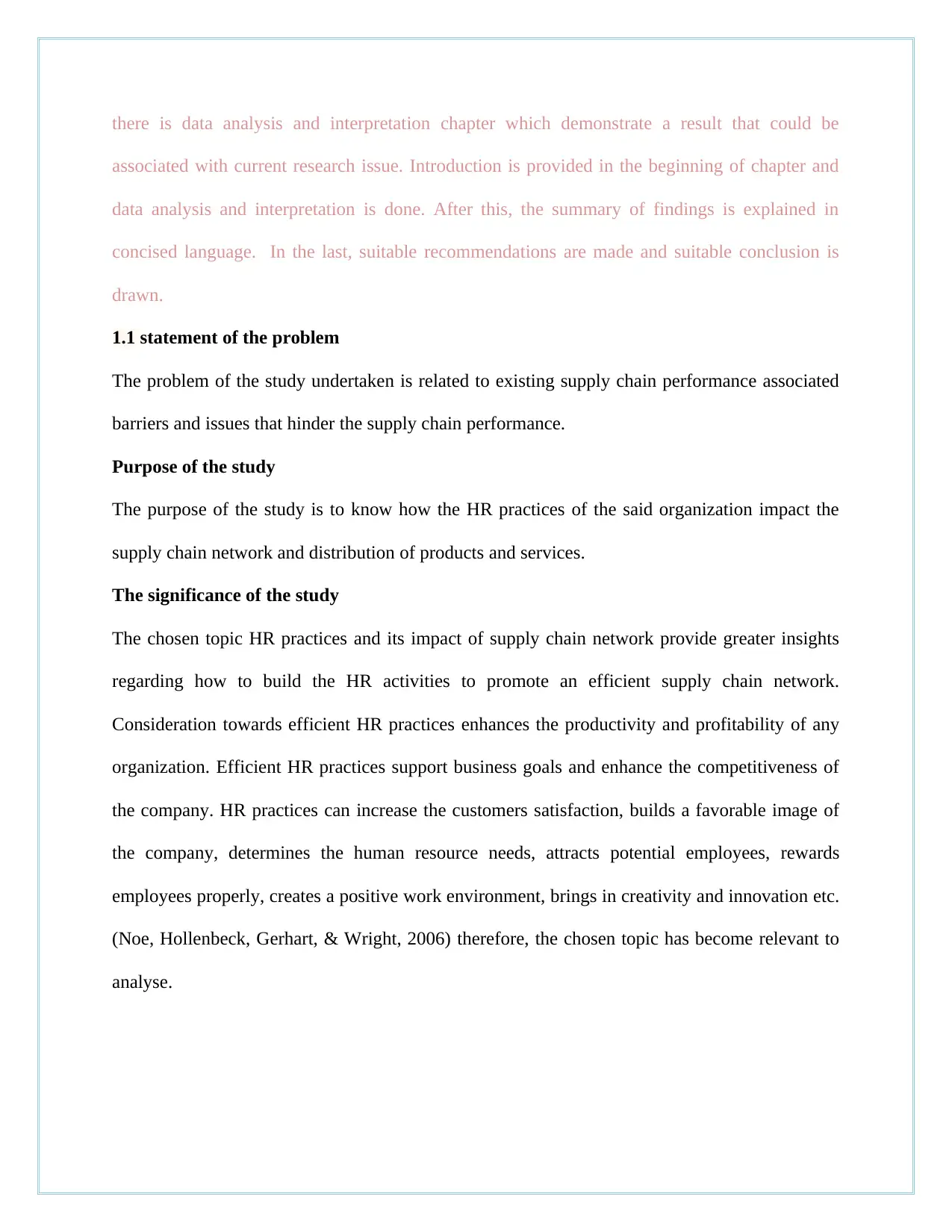
there is data analysis and interpretation chapter which demonstrate a result that could be
associated with current research issue. Introduction is provided in the beginning of chapter and
data analysis and interpretation is done. After this, the summary of findings is explained in
concised language. In the last, suitable recommendations are made and suitable conclusion is
drawn.
1.1 statement of the problem
The problem of the study undertaken is related to existing supply chain performance associated
barriers and issues that hinder the supply chain performance.
Purpose of the study
The purpose of the study is to know how the HR practices of the said organization impact the
supply chain network and distribution of products and services.
The significance of the study
The chosen topic HR practices and its impact of supply chain network provide greater insights
regarding how to build the HR activities to promote an efficient supply chain network.
Consideration towards efficient HR practices enhances the productivity and profitability of any
organization. Efficient HR practices support business goals and enhance the competitiveness of
the company. HR practices can increase the customers satisfaction, builds a favorable image of
the company, determines the human resource needs, attracts potential employees, rewards
employees properly, creates a positive work environment, brings in creativity and innovation etc.
(Noe, Hollenbeck, Gerhart, & Wright, 2006) therefore, the chosen topic has become relevant to
analyse.
associated with current research issue. Introduction is provided in the beginning of chapter and
data analysis and interpretation is done. After this, the summary of findings is explained in
concised language. In the last, suitable recommendations are made and suitable conclusion is
drawn.
1.1 statement of the problem
The problem of the study undertaken is related to existing supply chain performance associated
barriers and issues that hinder the supply chain performance.
Purpose of the study
The purpose of the study is to know how the HR practices of the said organization impact the
supply chain network and distribution of products and services.
The significance of the study
The chosen topic HR practices and its impact of supply chain network provide greater insights
regarding how to build the HR activities to promote an efficient supply chain network.
Consideration towards efficient HR practices enhances the productivity and profitability of any
organization. Efficient HR practices support business goals and enhance the competitiveness of
the company. HR practices can increase the customers satisfaction, builds a favorable image of
the company, determines the human resource needs, attracts potential employees, rewards
employees properly, creates a positive work environment, brings in creativity and innovation etc.
(Noe, Hollenbeck, Gerhart, & Wright, 2006) therefore, the chosen topic has become relevant to
analyse.
⊘ This is a preview!⊘
Do you want full access?
Subscribe today to unlock all pages.

Trusted by 1+ million students worldwide
1 out of 75
Related Documents
Your All-in-One AI-Powered Toolkit for Academic Success.
+13062052269
info@desklib.com
Available 24*7 on WhatsApp / Email
![[object Object]](/_next/static/media/star-bottom.7253800d.svg)
Unlock your academic potential
Copyright © 2020–2025 A2Z Services. All Rights Reserved. Developed and managed by ZUCOL.




